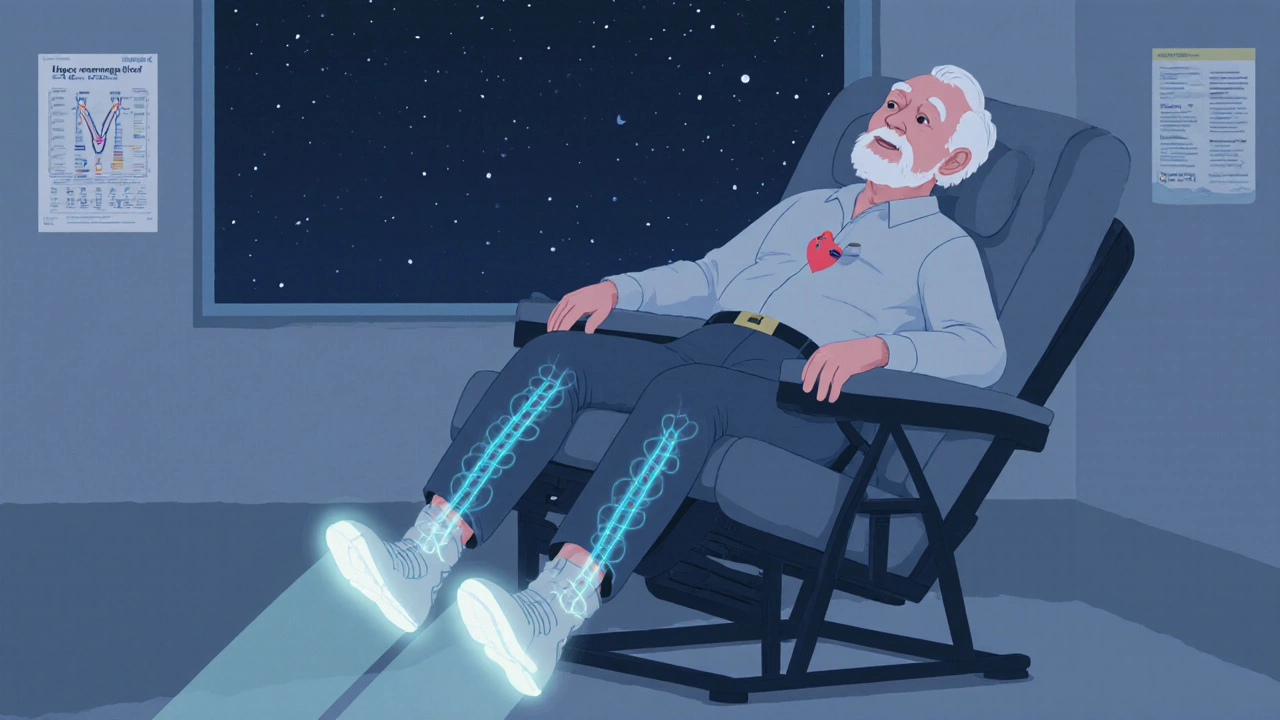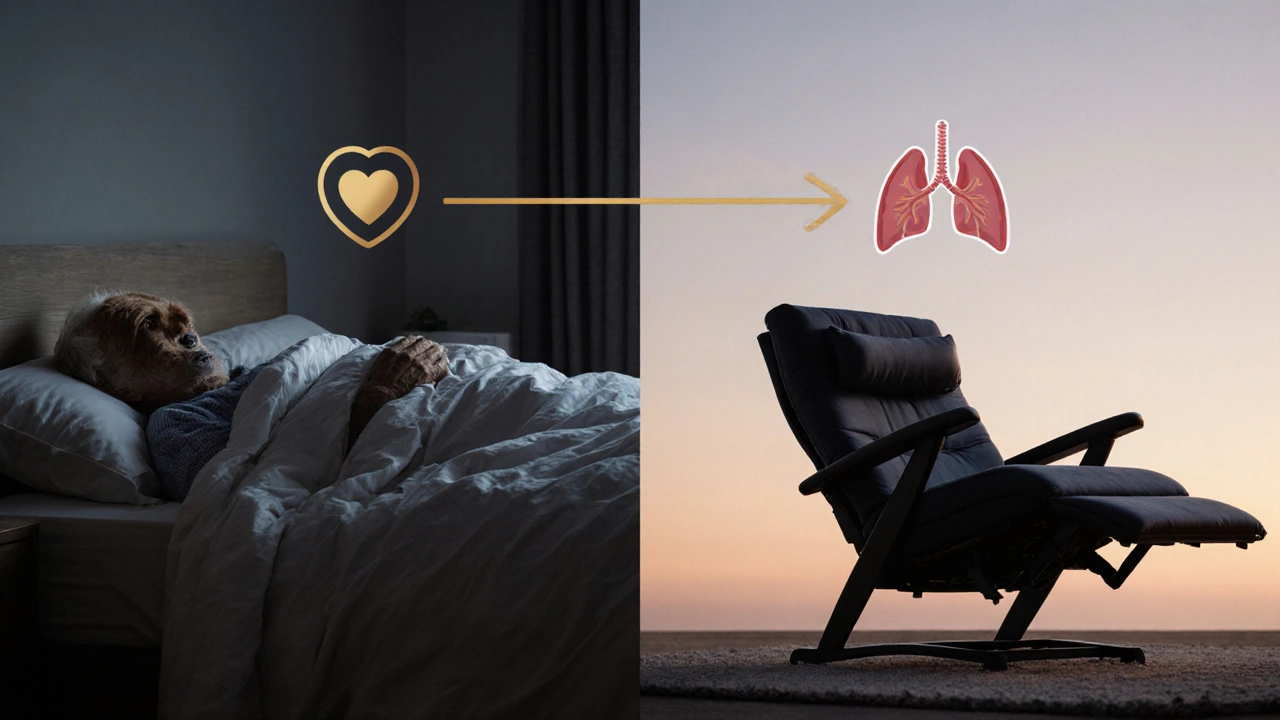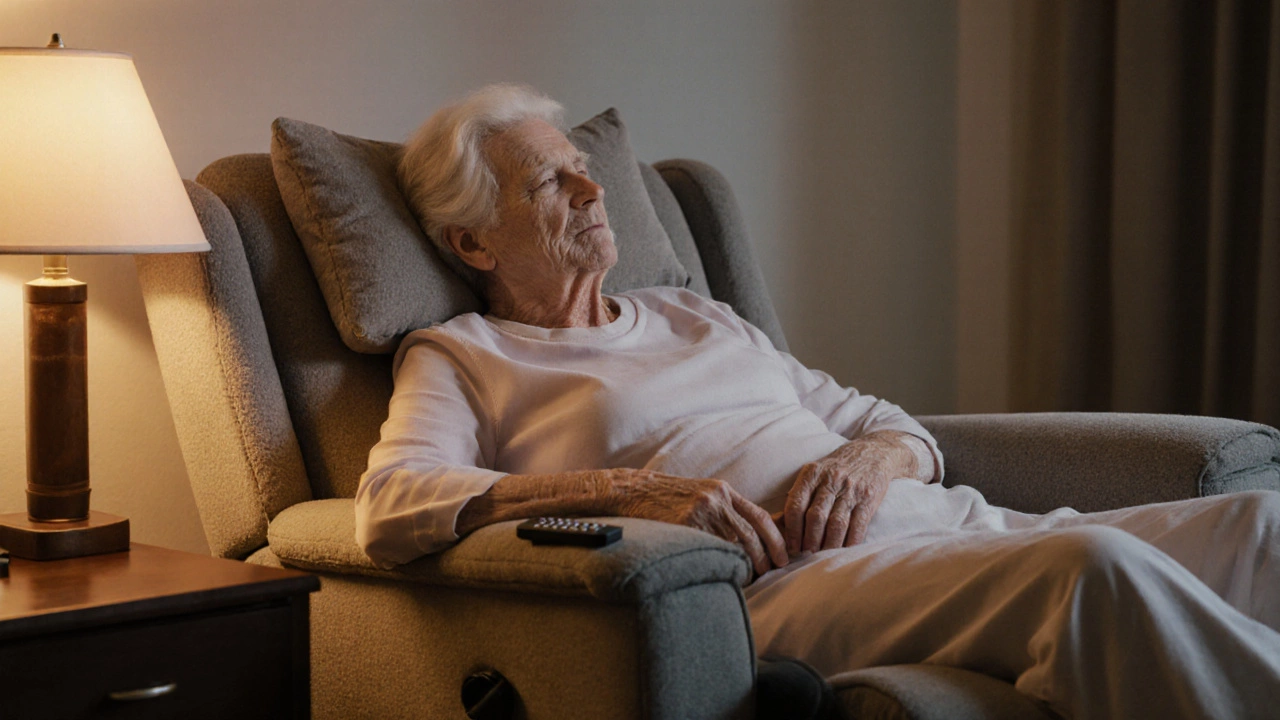Many seniors find it harder to sleep comfortably in a regular bed. Back pain, arthritis, acid reflux, or breathing issues like sleep apnea can make lying flat feel impossible. That’s why so many older adults turn to recliner chairs-not just for watching TV, but for actual sleep. But not all recliner positions are created equal. The wrong angle can worsen pain, restrict breathing, or cause swelling. So what’s the best position for seniors to sleep in a recliner?
Why Recliners Work Better Than Beds for Some Seniors
A regular flat bed might seem like the obvious choice, but for seniors with certain health conditions, it’s often the worst. Lying flat can increase pressure on the lower back, make it harder to breathe if you have COPD or heart failure, or cause stomach acid to rise into the esophagus. A recliner, when adjusted right, lifts the upper body and takes pressure off sensitive areas. It’s not a replacement for a good mattress, but for many, it’s a practical alternative.
Studies show that sleeping in a semi-upright position (between 30 and 45 degrees) helps reduce nighttime acid reflux in over 70% of people with GERD. For those with congestive heart failure, elevating the head by even 6 inches improves oxygen flow and reduces fluid buildup in the lungs. Recliners make this easy-no extra pillows needed.
The Ideal Recliner Sleep Position
The sweet spot for most seniors is a **35 to 45-degree recline angle** with the legs slightly elevated. This isn’t just about comfort-it’s about alignment. Here’s how to set it up right:
- Adjust the backrest so your head and neck stay in line with your spine. No tilting backward or forward.
- Use the footrest to lift your legs just above heart level. This helps circulation and reduces swelling in the ankles.
- Place a small pillow behind your lower back if the chair doesn’t provide enough lumbar support.
- Keep your arms supported on the armrests or with a soft pillow under each elbow.
- Make sure your knees aren’t bent too sharply. If your knees feel pinched, lower the footrest slightly.
This position mimics the semi-Fowler’s posture used in hospitals for patients with breathing or digestive issues. It’s simple, effective, and backed by clinical guidelines.
What to Avoid
Even with a good recliner, bad habits can undo the benefits. Here’s what not to do:
- Don’t sleep fully upright. A 90-degree angle puts too much strain on the neck and can restrict airflow.
- Avoid twisting your body. Turning sideways in a recliner can twist the spine and cause hip or shoulder pain.
- Don’t let your feet dangle. Unsupported feet lead to poor circulation and swelling.
- Skip the memory foam pillow under the head. It can push your chin down, blocking your airway. Use a thin, firm pillow instead.
- Don’t use a recliner without a safety lock. If the chair slips or moves while you’re dozing, you could fall.
One common mistake? Seniors think the more reclined, the better. But if the chair leans too far back, the spine curves unnaturally, and pressure shifts to the tailbone. That’s why adjustable models with a zero-gravity setting are so valuable.

Zero-Gravity Recliners: A Game Changer
Zero-gravity recliners are designed to mimic the weightless position astronauts use during launch. The legs are elevated above the heart, and the torso is slightly reclined. This takes pressure off the spine, reduces blood pressure, and improves circulation-all helpful for seniors.
Brands like La-Z-Boy, Human Touch, and Pride Mobility offer zero-gravity models with motorized controls, heat, and massage. These aren’t cheap, but they’re often covered by Medicare or private insurance if prescribed for conditions like edema, venous insufficiency, or chronic back pain. Check with your doctor or physical therapist-they may help you get one approved.
Even if you don’t get a premium model, look for a recliner with at least a 15-degree leg elevation and a firm, supportive back. Memory foam padding is good, but only if it doesn’t sink too much. Too soft = poor posture.
Recliner vs. Bed: When to Choose What
Not everyone needs a recliner to sleep. But here’s when it makes sense:
- Choose a recliner if you have GERD, sleep apnea, COPD, heart failure, chronic lower back pain, or swollen legs.
- Stick with a bed if you’re generally healthy, don’t have trouble breathing, and can turn easily during the night.
Some seniors use both: sleep in the recliner at night and lie flat on the bed during the day for stretching. That’s perfectly fine. The goal isn’t to replace the bed entirely-it’s to find relief where you need it most.
What to Look for When Buying a Recliner for Sleep
If you’re shopping for a recliner to sleep in, here’s what matters most:
| Feature | Why It Matters | What to Look For |
|---|---|---|
| Recline Angle | Too flat = no relief. Too upright = breathing trouble. | Adjustable between 30° and 50° |
| Leg Elevation | Reduces swelling and improves blood flow. | Footrest lifts legs above heart level |
| Lumbar Support | Prevents lower back strain. | Contoured back or adjustable lumbar pad |
| Material | Must be breathable and easy to clean. | Cotton blend, microfiber, or leather-avoid thick plush |
| Ease of Use | Seniors shouldn’t struggle to adjust it. | Power recline with remote, not manual lever |
| Weight Capacity | Too light = unsafe. | Minimum 300 lbs, preferably higher |
Don’t buy a recliner just because it looks nice. Test it out. Sit in it for 20 minutes. Try to fall asleep in it. Does your neck feel supported? Are your knees comfortable? Can you get out of it without help? If the answer is no to any of those, keep looking.

Real-Life Example: Margaret’s Story
Margaret, 78, from Birmingham, used to wake up three times a night with burning chest pain. Her doctor said it was acid reflux. She tried sleeping with two pillows, then three. Nothing worked. Her daughter bought her a power recliner with a zero-gravity setting. Within a week, her nighttime heartburn dropped by 80%. She now sleeps through the night. She doesn’t use it for TV-she uses it to sleep.
Her chair has a memory foam cushion on the seat and a washable cover. She keeps a small pillow behind her lower back. She doesn’t need a bed anymore-at least not for nighttime.
When to Talk to a Doctor
Recliners help with symptoms, but they’re not a cure. If you’re relying on one to sleep every night, it’s time to talk to your doctor. Underlying issues like sleep apnea, heart disease, or severe arthritis need proper diagnosis and treatment.
Ask your doctor about:
- Whether your sleep position could be worsening a medical condition
- If you qualify for a medically necessary recliner (some insurance plans cover them)
- Physical therapy options to improve mobility and reduce pain
Don’t assume discomfort is just part of aging. There are solutions-and a good recliner is often the first step.
Is it safe for seniors to sleep in a recliner every night?
Yes, if the recliner is properly adjusted and supports the spine, neck, and legs. Sleeping in a recliner is often safer than sleeping flat for seniors with acid reflux, sleep apnea, or heart issues. But it’s not ideal for long-term use without medical supervision. If you’re using one nightly, talk to your doctor to rule out underlying conditions.
Can a recliner cause back pain?
Absolutely-if it’s set wrong. Too reclined, and your spine curves unnaturally. Too upright, and your lower back loses support. The key is balance: a 35-45 degree angle with lumbar support. Also, avoid recliners with saggy cushions or no leg support. Poor design leads to poor posture, which leads to pain.
What’s better for sleep: a recliner or an adjustable bed?
An adjustable bed gives more flexibility-you can raise the head, feet, or both independently. But recliners are often more affordable, easier to move, and come with armrests and side pockets. For most seniors, a good recliner is enough. If you need fine-tuned positioning for multiple conditions (like diabetes and COPD), an adjustable bed might be worth the investment.
Do I need a special pillow for sleeping in a recliner?
Not necessarily, but the right pillow helps. Skip thick memory foam under your head-it pushes your chin down. Use a thin, firm pillow to keep your neck neutral. A small pillow behind your lower back can add support if the chair lacks it. For side sleepers in a recliner, a body pillow between the knees can reduce hip strain.
Are power recliners better for seniors than manual ones?
Yes, especially for those with arthritis, limited mobility, or weakness in the arms. Manual recliners require pulling levers or pushing with your legs, which can be difficult or painful. Power recliners let you adjust with a remote-no strain. Look for one with a battery backup in case of power outages.
Final Thoughts
There’s no one-size-fits-all answer to how seniors should sleep. But for many, a properly adjusted recliner offers more comfort, better breathing, and fewer nighttime disruptions than a flat bed. It’s not about giving up on the bed-it’s about choosing the right tool for the job. If you’re struggling to sleep, don’t just push through the pain. Try adjusting your chair. Talk to your doctor. And don’t be afraid to ask for help finding the right one. Comfort isn’t a luxury-it’s part of staying healthy as you age.


Write a comment